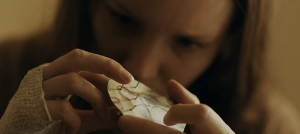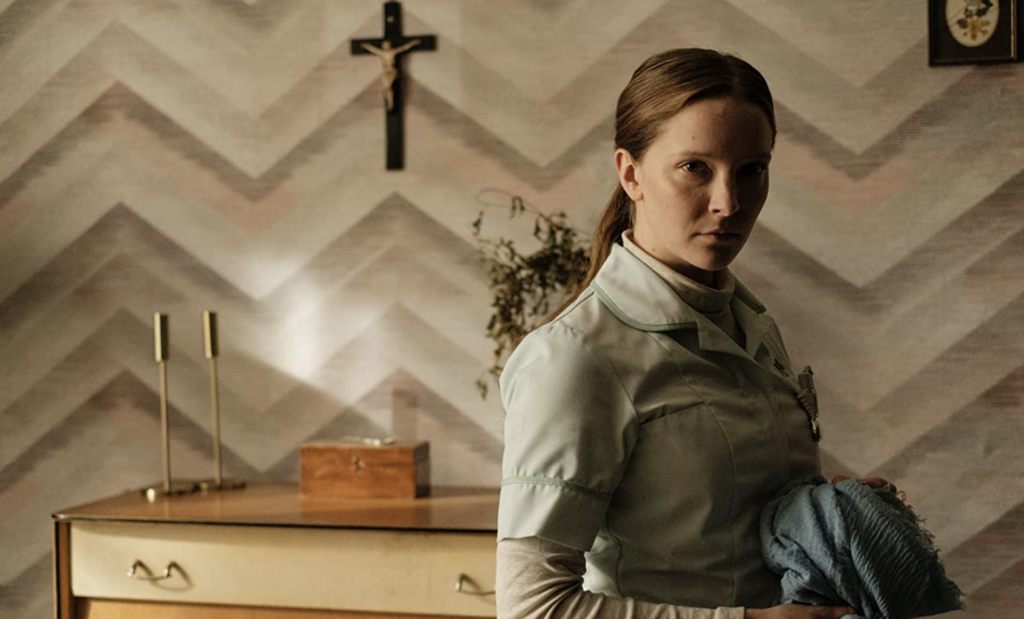Despite her exceptional title, the namesake character of “Saint Maud,” the newly released horror film from first-time filmmaker Rose Glass, is not the hero.
With wide eyes, vacant glances, and hair that frames the pale angles of her face, Maud (Morfydd Clark) looks like a specter haunting the halls of an old mansion that overlooks an English seaside town. She’s been hired to live there as a palliative care nurse for Amanda (Jennifer Ehle), a dying dancer. The patient smokes, drinks, and indulges herself into the late hours despite the devout Maud's attempts to save her soul.
Maud is a new convert to Catholicism and takes the call to evangelize to the extreme. Amanda is occasionally charmed by her caretaker’s earnestness, but Maud’s just another passing fancy for the bitter artist. At her worst, Amanda humiliates Maud, mocking her faith. This rejection only compels the obsessive Maud further. She believes God has gifted her with a new purpose, blurring the lines between faith and delusion.
Maud’s fragile psyche hangs by a thread, but Glass doesn't reduce her to a bible-thumping monster. Her trajectory is a very human one, fraught with personal and professional trauma, guilt, fear, and loneliness. She also shares the insecurities of any recent convert, still finding her way in the faith. Maud is at turns uncertain, impatient, and arrogant. Her conversations with God are candid.

“I always knew you had something more planned for me,” she says during prayer. “It takes nothing special to mop up after the decrepit and dying, but to save a soul ... that’s quite something.”
Maud feels tortured by her life before Christ. Her devotion to God is marked by blood and mortified flesh. After a desperate evening out on the town, awkwardly seeking companionship, Maud punishes herself for her transgressions by piercing her feet with nails. “Oh Lord, your mercy knows no bounds,” she praises.
It’s hard to say if the scars that mar Maud’s belly come from a self-harming past or her current religious fervor. While nonbelievers might say there’s little difference between the two, some of Catholicism’s most well-known saints and stigmatics — St. Catherine of Siena, St. Gemma Galgani, and Bl. Anne Catherine Emmerich among them — might say otherwise.
Like Maud, these women experienced intense physical pain and spiritual suffering, as well as visions and religious ecstasies. “Never waste your pain,” Maud repeatedly says throughout the film. She revels in the power of this redemptive pain, but her experiences are never transformed in a life-giving way. Her suffering never releases her from the cycle of shame and confusion, or the chaos she inflicts on those she attempts to connect with.
St. Paul also embraced redemptive suffering with a ferocity. He said, “My sorrow is so great, my mental anguish so endless, I would willingly be condemned and be cut off from Christ if it could help my brothers of Israel, my own flesh and blood.” But as Mother Angelica wrote, “Paul knew that God would never exact that price for the salvation of others, but he went to extremes in his desire to suffer for others so they too might come to know Jesus and enjoy His Kingdom.” This all-conquering love of Christ is witnessed in St. Paul’s mysterious “thorn in the flesh” that he agonizes over yet accepts as a source of strength.
“Power is made perfect in weakness,” the Lord told him.
Maud says she physically feels God within her, and her encounters with the divine are eroticized. In one scene, she is so completely enraptured that she levitates off the floor. The experiences of St. Teresa of Ávila come to mind, portrayed in breathtaking form by Italian sculptor Gian Lorenzo Bernini. In her autobiography, St. Teresa wrote:
“I saw in [the angel’s] hand a long spear of gold, and at the iron’s point there seemed to be a little fire. He appeared to me to be thrusting it at times into my heart and to pierce my very entrails; when he drew it out, he seemed to draw them out also, and to leave me all on fire with a great love of God. The pain was so great, that it made me moan; and yet so surpassing was the sweetness of this excessive pain, that I could not wish to be rid of it. The soul is satisfied now with nothing less than God.”

Witnesses also saw St. Teresa levitate off the ground during states of holy rapture, even though she tried to prevent it by weighing herself with stones and asking her fellow Carmelite sisters to hold her down.
The supernatural gifts and mortifications characteristic of many female saints — including levitation, bilocation, and “inedia prodigiosa” (also known as holy anorexia) — during the medieval period were met with great suspicion, the same as women accused of witchcraft, explains Caroline Walker Bynum in her book “Holy Feast and Holy Fast: The Religious Significance of Food to Medieval Women” (University of California Press, $33.95).
“The extreme asceticism and literalism of women’s spirituality were not, at the deepest level, masochism or dualism but, rather, efforts to gain power and to give meaning,” she writes on the ways female religious controlled and transcended their physicality. It was their way of “fusing with a Christ whose suffering saves the world.”
These intense expressions of spirituality and consecration with God found St. Catherine of Siena drinking pus from her patients’ sores, Bl. Stephana de Quinzanis tearing her own hair out by the roots, St. Rose of Lima disfiguring herself, and St. Angela of Foligno drinking the bathwater of a leper and consuming the afflicted’s scabs. Maud’s fleshy fixations remind us that the line between the horrific and the holy, particularly when it pertains to female bodies, is often blurry and in the eye of the beholder.
Ultimately “Saint Maud” troubles the soul, not because of its potent horror or sonorous-voiced devils, but because it’s the story of one lost and forgotten who falls into the wrong embrace. Maud’s former coworker Joy tells her that she could see Maud struggled for some time and laments not offering her support sooner. But it’s too late for Maud, already wrapped in her bedsheets and wandering the sand like a mad prophet. The dread we feel is not just about Maud’s inevitable downfall but the potential for our own, making us question whose voice we’re listening to in our darkest moments.

